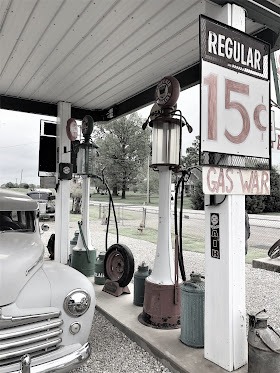May 9 135 miles Lebanon to Carthage
Woke up to a nasty rainy cold windy morning. Martha said if we were on the Loop and boating we'd just turn over and go back to bed rather than mess about in that kind of weather. But we've got places to go and things to see today so up and at 'em!!
Thankfully, the hard rain didn't last long and by the time we had finished breakfast all we required was an intermittent wipe of the windshield to keep things clear. Off we went to Marshfield, our first stop of the day to see the Hubble Telescope. Not the real thing but a 1/4 scale model. It honors Edwin Hubble who was a native of Marshfield. Lived from 1889 to 1953 and was considered an outstanding astronomer of the 20th century. His work in the 1920's and 1930's lead to the realization that there were galaxies beyond the Milky Way and out infinitely in the universe. He was basically the founder of the Big Bang theory. The Hubble Telescope sent into orbit in 1990 is named after him and still conducting research today.
On the way out of Marshfield we were unexpectedly surprised as we rounded a corner and saw another giant - this one as a chef. No mention of it in the guide book we're using but the cafe looked relatively new so probably explains why there is no "Giant Alert" mentioned. For some reason that face is starting to look vaguely familiar.
Next stop was Springfield, Capital of Missouri. Pretty nice downtown. Seemed to have a bunch of eateries but being pre lunchtime on a Mothers Day Sunday morning not much was going on. The museum looked interesting but didn't open until 1 so we were out of luck. The Gillioz Theatre built in 1926 was open for a church service so we stopped by the lobby for a couple of pictures. Quite ornate and impressively restored back in 2006.
And of course a number of murals painted about town. Some whimsy, some philosophical, some advertisements for business. All nicely done.
Next stop was Paris Springs and the well known "Gay Parita" tourist stop. We got talking with George who is the son-in-law of the now deceased original owners Gary and Lena Turner who collected, restored and displayed most of the items at this road side gift shop. We're finding that there's a strong comradery amongst all the Route 66 attractions. You mention where you're going or where you've been and invariably they tell you "Oh, say hi to so and so when you get there" or "Be sure and look up this or that attraction on the way" or "How is so and so doing back there?". They're miles apart but use the drivers coming through on Route 66 as their communication lines to each other much like it must have been many years ago. They all keep saying how much they missed having visitors last year keeping those communication lines open. Just past Gay Parita on a side road stretch of the original 1926 Route 66 is an old trestle bridge you cross before reaching the town of Spencer. The remains of the town were bought by a couple who have been slowly restoring them for no other reason than to see them preserved.
Our final destination for the day was the town of Carthage. Approaching town there are several metalwork sculptures by the artist Lowell Davis including "Crap Duster" - a flying manure spreader - and a car announcing the entryway towards his studio and home called Red Oak II. Unfortunately, he's another Route 66 icon who just recently passed away. He was known as the Norman Rockwell of Rural Art as most of his work included farm animals. He created a small town of his own making by relocating and restoring old buildings at Red Oak II. Everything from a one room school to blacksmiths shop to auto garages to homes were on his property which is still open for tourists to drive through. He is buried at the top of the hill in his towns cemetery.
Short driving day planned for tomorrow. We'll start by viewing the Route 66 Drive-in just outside of Carthage before heading to the border and moving westward to Oklahoma!
"Crap Duster" by artist Lowell Davis
We finally made it to Carthage. Home to another spectacular courthouse on their square. The town holds an annual Maple Tree festival and along with them being predominant along several residential streets they also have been planted around the courthouse. I'm sure the fall foliage is spectacular.
Carthage was the site of one of the very first Civil War battles and they have an informative museum that does a nice job covering the conflicts perspectives from both sides. Missouri was a "neutral" state entering the war with the population very split regarding their loyalties. States rights were an important issue to many. Slavery was allowed although there were very few as most farming was subsistence family size and not large plantations. From the Union perspective getting Missouri under their control was critical as major supply routes via the Mississippi and Missouri Rivers could then be controlled. Ultimately the Union gained control here. After visiting the museum we finally made our way to our home for the night - Boots Court. Small original motorcourt motel with period correct furnishings right down to only an antique radio - no TV's allowed. At least they have good wifi!!





























I know those areas
ReplyDeleteReally well!